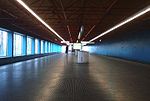Basilica of the Sacred Heart, Brussels

The National Basilica of the Sacred Heart (French: Basilique Nationale du Sacré-Cœur, Dutch: Nationale Basiliek van het Heilig-Hart) is a Roman Catholic Minor Basilica and parish church in Brussels, Belgium. The church is dedicated to the Sacred Heart, inspired by the Basilique du Sacré-Coeur in Paris. Symbolically, King Leopold II laid the first stone of the basilica in 1905 during the celebrations of the 75th anniversary of Belgian Independence. The construction was halted by the two World Wars and finished only in 1969. Belonging to the Metropolitan Archdiocese of Mechelen–Brussels, it is one of the largest churches by area in the world. Located in the Parc Elisabeth atop the Koekelberg hill at the border between Brussels' Koekelberg and Ganshoren municipalities, the church is popularly known as the Koekelberg Basilica (French: Basilique de Koekelberg, Dutch: Basiliek van Koekelberg). The massive brick and reinforced concrete church features two thin towers and a green copper dome that rises 89 metres (292 ft) above ground, dominating Brussels' north-western skyline. It is served by Simonis metro station on lines 2 and 6 of the Brussels Metro.
Excerpt from the Wikipedia article Basilica of the Sacred Heart, Brussels (License: CC BY-SA 3.0, Authors, Images).Basilica of the Sacred Heart, Brussels
Parvis de la Basilique - Basiliekvoorplein,
Geographical coordinates (GPS) Address External links Nearby Places Show on map
Geographical coordinates (GPS)
| Latitude | Longitude |
|---|---|
| N 50.866666666667 ° | E 4.3172222222222 ° |
Address
Basilique du Sacré-Coeur - Basiliek van het Heilig Hart (Basilique de Koekelberg - Basiliek van Koekelberg)
Parvis de la Basilique - Basiliekvoorplein 1
1083
Belgium
Open on Google Maps









